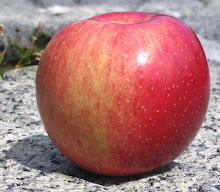A famous cooking apple, sometimes called "Northern Pie," this heirloom is also great for eating and is still enjoyed across the Northeast.
 |
Northern Spy is large, very ribbed, and a little gnarly. A streaky red blush mostly covers yellow-green (actually more yellow than green).
My example has a small patch of tiny black russet spots, a wen-like extrudence, and numerous small dents and bruises.
Most of these are probably from my own ham-handling, but they suggest a sensitive vulnerability.
So, no beauty queen, but a right stout-looking apple. It smells faintly, and sweetly, of cider.
The flesh is yellow, juicy, and coarse. The bite is a little tender but still crisp. I'm not sure when this was picked, but the texture turns just a little mealy into the chew. The apple oxidized quickly.
A hint of acid tartness gives this apple a bit of life and character on the tongue. Still Northern Spy is mostly a mild cidery apple with a few higher notes. Hint of spice, pear, and cherry, very agreeable.
 Many sources repeat, without attribution, the story that Northern Spy was found in an orchard in East Bloomfield, New York; some of these provide further information.
Many sources repeat, without attribution, the story that Northern Spy was found in an orchard in East Bloomfield, New York; some of these provide further information.
The basis for this history may be an 1847 letter from Oliver Chapin, who wrote
The first Northern Spy apple trees were raised from seeds brought from the Northwest part of Connecticut, about the year 1800, by Elijah Taylor. The original tree was set in an orchard by Heman Chapin, and some sprouts were taken from it by Roswell Humphrey, and by him the fruit was first raised...as the original tree died before bearing. (original emphasis)
See Watts, J. H., “Additional Remarks on the Northern Spy Apple” Magazine of Horticulture, Botany, and All Useful Discoveries and Improvements in Rural Affairs 13(1847):104-105.
The American Chemical Society found that Northern Spy (and two other varieties) have the most antioxidents of any variety of apple.
See Tsao, Yang, Young, and Zhu, "Polyphenolic Profiles in Eight Apple Cultivars Using High-Performance Liquid Chromatography" J. Agric. Food Chem. 51(2003):21, 6347 - 6353.
On that scholarly note (who says you can't document this stuff?) the legendary Adam's Apple Research Department is pleased to call it a day.

I have found this apple develops a very nice flavor after being left in the fridge for a week or two.
ReplyDeleteIt's a famous, must-try variety, inside of a pie or out.
DeleteOr, straight, after washing, from the ground as a drop.
ReplyDeleteThis makes the best pies, hands down. Unfortunately, where I live, the Northern Spy is becoming more difficult to come by, as it is apparently the favored apple for cider houses due to its size and unique cider-y flavor. I nabbed the last bag in the county (it seemed!) last fall to make my Thanksgiving pies, and they were rather pitiful specimens - badly bruised, a bit soft....but the pies? Gustatory perfection (if I may say so myself!). This is an old variety well worth seeking out for anyone wanting to make the perfect pie!!!
ReplyDeleteBecca, I was unaware of the cider connection, thanks!
DeleteToo bad if they are all going to drink, but consider the fate of some other heritage apples that can't be found because no one grows them at all.
There are worse fates than to be in high demand.
Presumably if it goes on farmers will plant some new Spy trees, and those will be good for another generation or longer.
That is a point well taken! I have to admit to breaking down in tears when the old orchard nearby uprooted the old trees to replace them with high-yield dwarf varieties. There were 2 Northern Spy trees they took down, and the memories of climbing those trees as a child, looking out over the Catskill Mountains, and surrounded by the most enormous apples - about as close to heaven as one can imagine. The long and short of it is, you are absolutely right: demand can surely work wonders for preservation!
DeleteOne of my three favorite pie apples: Spies for pies!
ReplyDeleteWhat are your other two?
DeleteGoldrush is my pie apple. In February, March and May.
DeleteI grow Northern Spy in SE WI. Ripens very late (Late October) for me although we warm up slowly in spring being so close to the West side of Lake Michigan. Makes a bright yellow applesauce. The fruit can be gigantic in size! While considered a cooking apple I like to eat it fresh. Only drawback is the fruit is so large hard to find small ones for fresh eating.
ReplyDeleteI meant, one could just peel red delicious and eat the peel. Of course, one could peel it and Northern Spy and eat the flesh to remove most of the health benefits from the antioxidants. But that isn’t what I meant.
ReplyDelete